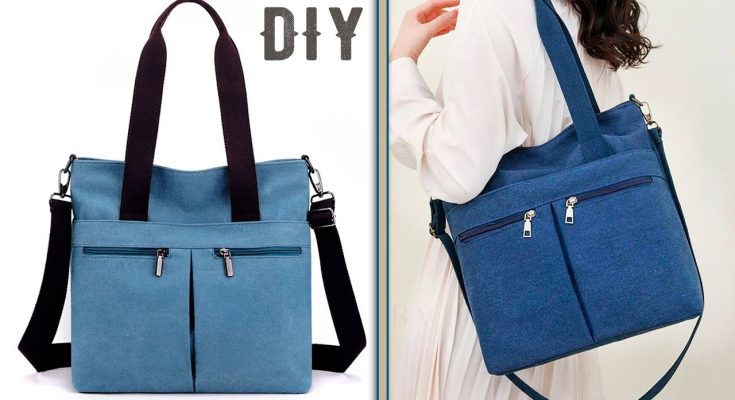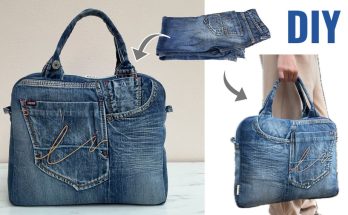Making a women’s denim tote bag with many pockets is a fantastic DIY project! It’s a super practical and stylish way to repurpose old jeans, creating a durable bag that’s perfect for everyday use, whether for work, groceries, or just carrying your essentials. The beauty of denim is its strength and the character it gains over time, and adding multiple pockets makes it incredibly functional.
This detailed guide will show you how to sew a versatile medium-to-large sized denim tote bag with a flat, boxed bottom, a full lining, sturdy fabric handles, and several pockets – including repurposed jean pockets on the exterior and multiple slip pockets on the interior. We’ll aim for a finished size of approximately 14 inches wide x 15 inches tall x 4 inches deep (35.5 cm W x 38 cm H x 10 cm D), providing ample space and organization.

How to Sew a Women’s Denim Tote Bag with Many Pockets (DIY)
I. Planning Your Multi-Pocket Denim Tote
Careful planning is key to a functional and beautiful outcome, especially with multiple pockets.
- Denim Supply: You’ll need at least 1-2 pairs of adult jeans (men’s larger sizes or women’s plus sizes are great for larger pieces of fabric). More if you want extensive patchwork or many small pockets.
- Prioritize non-stretch or low-stretch denim. High-stretch denim can be tricky to work with for structured projects and may not hold its shape as well.
- Make sure your jeans are clean and ironed before you start. Different washes (light, medium, dark) can add great visual interest if you plan to piece panels together.
- Pocket Strategy: This is where the “many pockets” come in!
- Exterior Pockets: The easiest way to add exterior pockets is to repurpose the back pockets of your jeans. You might use two on the front, or one on the front and one on the back.
- Interior Pockets: You can add one or more slip pockets to the lining. Consider a single wide pocket divided into sections, or several individual pockets for phone, pens, keys, etc.
- Lining Fabric: Essential! A lining gives your tote a professional, clean finish, hides all raw seams, and adds an extra layer of durability. Choose a medium-weight cotton fabric (like quilting cotton or broadcloth) that complements your denim. A lighter color or fun print for the lining can make it easier to find items inside.
- Structure:
- Heavyweight Fusible Interfacing: This is critical! It gives your tote body and helps it stand up on its own, preventing it from being flimsy. Pellon 809 Decor Bond or Pellon 71F Peltex II Ultra Firm are good choices.
II. Gather Your Materials
Having all your supplies ready before you start sewing will make your project much smoother.
- Old Jeans: At least 1-2 pairs of clean, ironed, sturdy denim jeans with intact back pockets.
- Lining Fabric: 1 yard (0.9 meters) of medium-weight quilting cotton or broadcloth.
- Heavyweight Fusible Interfacing: 1 yard (0.9 meters).
- Matching Thread: Strong, all-purpose polyester thread that blends with your denim and lining. For topstitching on denim, use a slightly thicker topstitching thread in a contrasting color (like gold, orange, or beige) for that authentic jean look.
- Basic Sewing Supplies:
- Sewing Machine: Your machine should be able to handle thicker fabrics. A denim needle (size 90/14 or 100/16) is essential for piercing tough denim. Keep spares on hand. A walking foot is highly recommended for evenly feeding multiple layers of denim and interfacing.
- Sharp Fabric Scissors or Rotary Cutter and Mat.
- Long Quilting Ruler or Measuring Tape.
- Fabric Chalk, Frixion Pen, or Mark-B-Gone Pen.
- Plenty of Wonder Clips (these are far superior to pins for holding thick denim layers!).
- Iron and Ironing Board (absolutely crucial for pressing seams flat and fusing interfacing).
- Seam Ripper (your best friend for deconstructing jeans and correcting any mistakes!).
III. Prepare Your Jeans & Cut Fabric Pieces
Accuracy in cutting leads to a well-fitting, professional-looking bag. We’ll use a consistent 1/2-inch (1.27 cm) seam allowance throughout this tutorial.
- Desired Finished Tote Size: 14″ W x 15″ H x 4″ D (35.5 cm W x 38 cm H x 10 cm D).
A. Deconstruct Your Jeans & Harvest Pockets:
- Cut Off Legs: Lay your jeans flat and smooth. Using sharp scissors, cut straight across both pant legs, just below the crotch seam.
- Open Leg Seams: Use your seam ripper to carefully open up both the inseam (inner leg seam) and the outseam (outer leg seam) of each cut-off leg. This will give you large, flat panels of denim fabric. Iron these flat to remove creases.
- Carefully Remove Back Pockets: Using your seam ripper, carefully detach the two back pockets from the jeans. Go slowly to avoid tearing the surrounding denim. These will be your exterior pockets!
B. Calculate Your Main Panel Sizes:
- Main Body Panel Width: Finished Width + Finished Depth + (2 * Seam Allowance) = 14″ + 4″ + 1″ = 19 inches (48.3 cm)
- Main Body Panel Height: Finished Height + Finished Depth + (2 * Seam Allowance) = 15″ + 4″ + 1″ = 20 inches (51 cm)
C. Cut Your Fabric Pieces:
- Exterior Denim Pieces:
- Main Body (Front & Back): Cut 2 rectangles, each 19 inches wide x 20 inches high.
- Important Note on Piecing: It’s highly likely you’ll need to piece together sections of your opened jean legs to get these large panels.
- How to Piece Denim: Place two denim pieces right sides together, aligning a raw edge. Stitch them with a 1/2-inch (1.27 cm) seam allowance. Press the seam open thoroughly to reduce bulk. Topstitch (Highly Recommended!): On the right side, sew two parallel lines of stitching, one on each side of the seam line, about 1/8 inch (0.3 cm) away. Use topstitching thread for this. This mimics authentic jean seams and adds strength and a decorative touch. Continue piecing until you have two panels large enough for your final 19″x20″ cut.
- Handle Pieces: Cut 2 rectangles, each 4 inches wide x 25 inches long. (Adjust length for your preferred handle drop; 25 inches is a good shoulder strap length). You may also need to piece these from denim scraps.
- Main Body (Front & Back): Cut 2 rectangles, each 19 inches wide x 20 inches high.
- Lining Fabric Pieces:
- Main Body (Front & Back): Cut 2 rectangles, each 19 inches wide x 20 inches high.
- Interior Slip Pocket(s):
- Single Pocket: Cut 1 rectangle, 8 inches wide x 10 inches high.
- Multi-Section Pocket: Cut 1 rectangle, 12 inches wide x 10 inches high. (You’ll sew divisions later).
- Heavyweight Fusible Interfacing:
- Main Body Panels: Cut 2 rectangles, each 18 inches wide x 19 inches high (1 inch smaller on all sides than your main fabric panels to keep bulk out of the seam allowances).
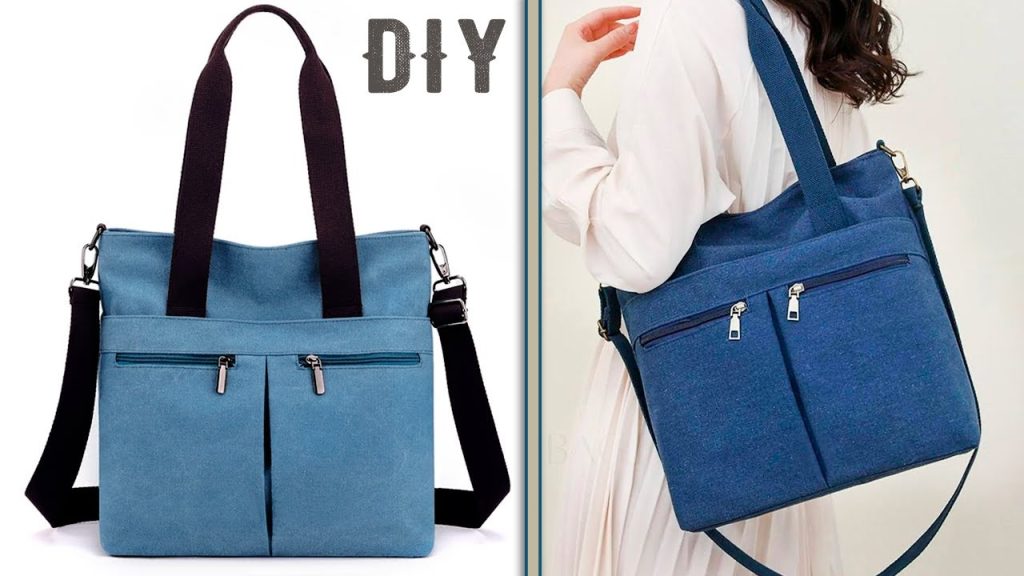
IV. Let’s Start Sewing Your Multi-Pocket Tote Bag!
General Sewing Tips for Denim:
- Press, Press, Press: This is the most crucial step for a crisp, professional-looking bag. Press seams open after each stitching step.
- Backstitch: Always backstitch at the beginning and end of each seam to secure your stitches.
- Walking Foot: Use it! It makes a huge difference when sewing multiple layers or thicker fabrics, ensuring even feeding.
- Clips: They’re excellent for holding thick layers and handles in place, much better than pins!
- Go Slow: Take your time, especially when sewing around corners or through thick areas. Precision over speed!
- Topstitching: Use a slightly longer stitch length (3.0-3.5mm) for topstitching for a more professional, intentional look.
Step 1: Fuse Interfacing & Attach Exterior Pockets
- Fuse Interfacing: Take your two Exterior Denim Main Body Panels. Lay each one wrong side up on your ironing board. Center one Interfacing piece on each fabric panel. Following the manufacturer’s instructions, fuse it firmly to the wrong side of the fabric. Press evenly and allow to cool completely. This gives your tote structure and body.
- Attach Exterior Jean Pockets:
- Take your two salvaged jean pockets. Decide if you want one on the front and one on the back, or both on the front.
- Position a pocket onto the right side of your Exterior Denim Main Body Panel. Typically, you’d center it horizontally and place its top edge about 3-4 inches (7.6-10 cm) down from the top raw edge of the panel. You can play with placement for your desired look.
- Topstitch each pocket onto its denim panel along its two sides and bottom edge, sewing very close to the original stitching lines on the pocket. Ensure the top opening of the pocket remains open!
- Reinforce the top corners of each pocket opening with a small triangle stitch or extra back-and-forth stitches for durability, as these areas will see stress.
Step 2: Prepare and Attach Interior Slip Pocket(s)
- Single Slip Pocket:
- Take your 8″ x 10″ pocket piece (lining fabric).
- Fold one long 8-inch edge down by 1/2 inch (1.27 cm) towards the wrong side and press. Fold it down again by another 1/2 inch and press. Stitch this double-folded hem in place, close to the inner fold. This is the top edge of your pocket.
- Fold the remaining three raw edges (the two short 10-inch sides and the bottom 8-inch side) in by 1/2 inch and press.
- Position this prepared pocket onto the right side of one of your Lining Fabric Main Body Panels. Center it horizontally, about 4-5 inches (10-12.7 cm) down from the top raw edge.
- Topstitch the pocket in place along its two sides and bottom edge, close to the folded edges. Backstitch at the beginning and end, and reinforce the top corners.
- Multi-Section Slip Pocket (Optional – for more organization):
- Take your 12″ x 10″ pocket piece (lining fabric).
- Prepare the top hem and side/bottom folds exactly as described for the single slip pocket.
- Position the pocket onto the right side of one Lining Fabric Main Body Panel (centered horizontally, 4-5 inches down from the top).
- Topstitch the pocket to the lining panel along its two sides and bottom edge.
- To create divisions: Decide how many sections you want (e.g., two 6-inch sections, or one 4-inch and one 8-inch). Draw vertical lines with chalk from the top hem of the pocket down to the bottom stitching line to mark your divisions. Stitch along these lines, backstitching securely at the top and bottom of each division. This creates separate compartments.
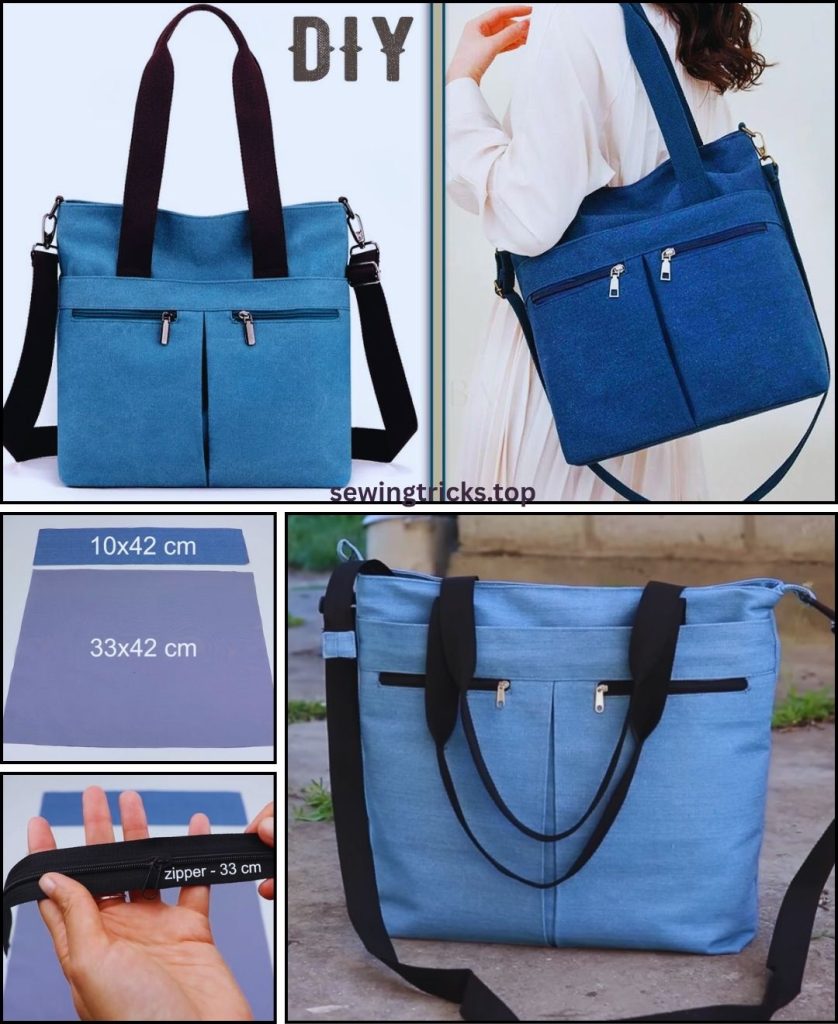
Step 3: Prepare and Attach Denim Handles
- Take one Handle Piece (4″ x 25″). Fold it in half lengthwise, wrong sides together, and press firmly along the fold. Open it up.
- Fold each long raw edge in towards the center crease you just made, and press again.
- Fold the entire strip in half again along the original center crease. You should now have a long, flat handle that is about 1 inch (2.5 cm) wide with no raw edges visible. Press firmly along the entire length.
- Topstitch down both long sides of the prepared handle, about 1/8 inch (0.3 cm) from the edge. Use topstitching thread if desired. This secures all the folds and makes a neat, strong handle.
- Repeat this process for the second handle piece.
- Attach to Exterior Bag Panels:
- Lay one Exterior Denim Main Body Panel (with fused interfacing and exterior pockets) right side up.
- Measure in from each side edge about 4-5 inches (10-12.7 cm) along the top raw edge of the panel. Mark these points with fabric chalk. This is where your handles will attach.
- Position the raw ends of one prepared handle on the top raw edge of the panel at your marks. Make sure the handle itself is flat and not twisted. The handle should be pointing down into the panel. Clip securely.
- Stitch the handle ends in place. For a strong hold, sew a small square (about 1×1 inch) with an “X” inside it (an X-box stitch) for maximum reinforcement, as these handles will bear weight. Perform this stitching within the 1/2-inch (1.27 cm) seam allowance, close to the raw edge.
- Repeat for the second exterior panel with the second handle.
Step 4: Sew the Bag Body (Exterior and Lining)
- Exterior Bag: Place your two Exterior Denim Main Body Panels right sides together. The handles should be tucked inside. Clip or pin along both side edges and the entire bottom edge.
- Stitch from one top corner down that side, pivot sharply at the bottom corner, stitch straight across the bottom, pivot again, and stitch up the other side to the top corner. Backstitch at the beginning and end of your seam.
- Press all seams open thoroughly to reduce bulk.
- Lining Bag: Now, prepare your Lining Fabric Main Body Panels (with interior pocket attached). Place them right sides together. Clip or pin along both side edges.
- CRUCIAL STEP: For the bottom seam of the lining, you must leave an opening! Stitch down one side seam. Then, for the bottom seam, stitch approximately 3 inches (7.6 cm) from one side, then leave a 4-6 inch (10-15 cm) unstitched gap in the middle of the bottom seam. This opening is absolutely essential for turning the entire bag right side out later. After the gap, stitch for another 3 inches (7.6 cm) to reach the other side seam. Backstitch well at the start and end of your stitching around the gap.
- Stitch up the second side seam of the lining.
- Press all lining seams open.
Step 5: Box the Corners (Exterior and Lining)
This step creates the flat, defined bottom of your tote bag, giving it shape and stability.
- At one of the bottom corners of the exterior denim bag, carefully bring the side seam and the bottom seam together, aligning them perfectly. This will naturally form a triangular shape at the corner.
- Measure from the tip of this triangle inward along the seam line a distance equal to half of your desired bag depth (e.g., for a 4-inch deep bag, you’ll measure 2 inches / 5 cm).
- Draw a straight line perpendicular to the seam at this measured point. (This line will be 4 inches long if your desired depth is 4 inches).
- Clip firmly along this drawn line.
- Stitch precisely along the drawn line, backstitching securely at both ends.
- Trim the excess fabric from the corner, leaving about a 1/2-inch (1.27 cm) seam allowance beyond your new stitching line.
- Repeat this exact process for all three remaining corners (the other exterior corner and both lining corners).
- Result: Both your exterior denim bag and your lining bag now have structured, flat bottoms. Keep the exterior bag right side out and the lining bag wrong side out.
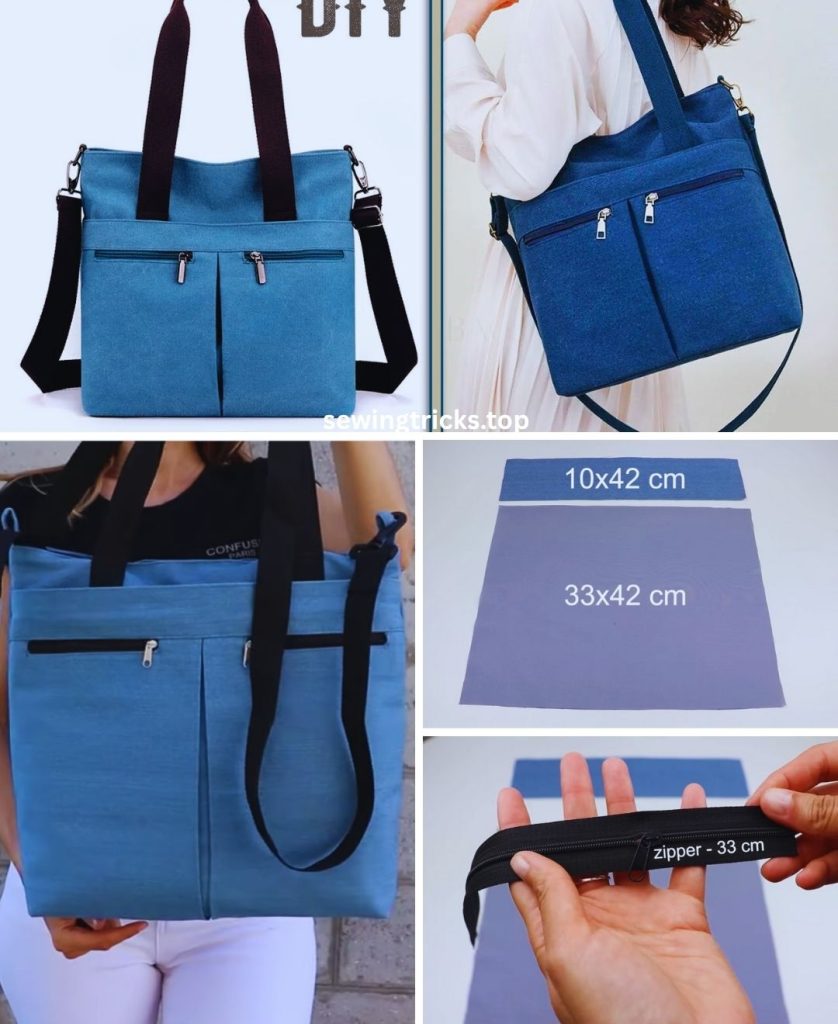
Step 6: Final Assembly (The “Bag-in-a-Bag” Method)
- Carefully insert the exterior denim bag (which is right side out, with handles pointing down inside) into the lining bag (which is wrong side out and has the turning opening).
- The right sides of both bags should now be facing each other.
- Align the side seams of the exterior bag with the side seams of the lining bag.
- Align the top raw edges of the exterior fabric and the lining fabric all around the entire opening of the bag. The handles should be tucked well inside between the layers.
- Clip very securely all the way around this top opening, matching up seams precisely.
- Stitch all the way around the entire top opening of the bag, using a 1/2-inch (1.27 cm) seam allowance. Go slowly and carefully, especially over the thick areas where the handles are attached. Backstitch at the beginning and end of your seam.
- Trim Bulk: Carefully trim the seam allowance at the top down to about 1/4 inch (0.6 cm) to reduce bulk inside the top edge for a smoother finish.
Step 7: Turn Your Bag Right Side Out & Finish!
- Reach through the opening you left in the bottom seam of the lining (Step 4).
- Slowly and carefully pull the entire bag (exterior, lining, handles – everything!) through this opening until it is completely right side out. Take your time, gently pushing out all the corners for a crisp, well-defined shape.
- Close the Lining Opening: Go to your ironing board. Press the raw edges of the opening in the bottom of the lining under by 1/2 inch (1.27 cm) so they meet neatly. Align these pressed edges and clip them together. Stitch this opening closed by machine (sewing very close to the folded edge for a neat finish) or by hand using an invisible ladder stitch for a truly seamless look.
- Now, gently push the lining down into the exterior denim bag, ensuring it sits smoothly inside and the top edges are even.
- Final Press & Topstitch: Carefully press the entire top edge of the bag, ensuring the lining is fully tucked inside and isn’t peeking out over the top edge of the exterior fabric.
- For a super polished and durable finish, topstitch all around the entire top opening of the tote, sewing about 1/8 inch (0.3 cm) from the edge. This final topstitching marries the lining to the exterior, helps the bag hold its shape, and creates a crisp, professional look. You can also sew a second row of topstitching about 1/2 inch (1.27 cm) from the top edge for added detail and stability.
Your unique, upcycled Women’s Denim Tote Bag with Many Pockets is now complete! You’ve transformed old jeans into a highly functional, durable, and stylish accessory. Enjoy carrying your sustainable creation with pride!
What unique details from your original jeans did you manage to incorporate into your new tote’s design?

